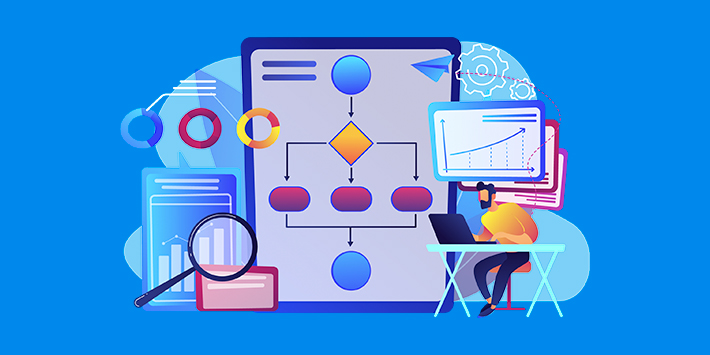
With rapid technological advancement, the market has become more competitive than ever. As a result, it’s vital that your business invests in cutting-edge technology to improve productivity and efficiency. Any company looking to optimize the customer experience while increasing profits should look to automation for help.
Business process automation allows you to focus on complex tasks while leaving time-consuming, repetitive work to technology. Automation software helps to streamline workflows, reduce costs, maximize efficiency, and increase profit. With automation, you can develop data-driven approaches to your unique process needs.
Using solutions like workflow automation can benefit your organization helps you source the best tools for exceeding your goals and developing the edge you need to outcompete the competition.
Business automation workflow (BAW) Workflow automation involves using technology to design, execute, and manage a sequence of tasks or processes within a business, reducing manual intervention and increasing efficiency. Many workers perform repetitive activities and tasks — this takes lots of time and resources, slowing down productivity and wasting resources and employees that could be better used elsewhere.
Automating business processes involves designing, executing, and monitoring workflows through software. This solution allows you to improve workplace efficiency and reduce manual intervention, which is otherwise much slower. Specialized software allows you to streamline and automate these repetitive tasks for increased productivity and cost-effectiveness.
The software’s accuracy and rapid processing help cut task times and minimize errors. Actions like document routing, notifications, approvals, and data entry can all be improved through automation. Selecting tasks for automation enables you to use employees more effectively, engaging them with complex tasks that can’t be done with automation and maximizing workplace productivity.
There are many benefits of automation, and businesses looking to optimize their processes and create a more efficient, productive workflow should consider investing in automation software. With enhanced control and reduced bottlenecks through software, you’ll save time and revenue while surpassing customer expectations.
Letting technology take care of your less-intensive tasks puts your best creative focus on complex processes, helping you develop more sophisticated solutions to answer your target market’s needs. Here are the benefits of investing in business automation:
Letting software handle repetitive tasks can improve process productivity. Automation software streamlines your business processes, completing tasks more efficiently and managing them for your employees. Employees who no longer need to take time to make schedules, send notifications, and work on document management can focus on more critical, complex tasks.
The software can also perform many tasks at once. While humans need to complete one task at a time to ensure accuracy, computers can receive and complete more rote tasks in less time than one employee. With work getting done faster and more accurately, your productivity increases.
Overall, every workflow process will see better, faster completion for optimized business productivity.
Efficiency and productivity go hand-in-hand. The more efficient your processes, the more productive your business is. Automation helps streamline operations, reduce bottlenecks, and cut errors. By minimizing these hang-ups, automation makes your business more efficient.
Because software uses minimal resources, your spending also becomes more efficient, letting you allocate resources to other processes that need more focus. With resources going where needed, software finishing many repetitive jobs, and employees working on complex tasks, your entire operation will run more efficiently than ever.
While every company focuses on hiring skilled employees, humans do make mistakes. Working on repetitive, unengaging tasks can lead to absent-mindedness and multi-tasking, increasing the chance of error. The software doesn’t get distracted like employees, so it always provides the same accuracy to every new task. Automating workflow processes helps reduce human error, where precision is essential.
Additionally, the software’s accuracy helps every aspect of your business processes. With better accuracy from automated tasks, employees farther along in the process have a more reliable foundation to work off of. They’ll have better response times and more accurate results if they have software-accurate data to work from.
All components of your business processes will see improved accuracy when you use automation.
Workflow processes don’t directly generate revenue for your organization — they support other processes that directly generate revenue. Using employees to complete these processes manually consumes labor and costs that software doesn’t have. Switching to automated tasks cuts operational costs for employing people for these tasks and covers the time they take to complete.
With software handling repetitive tasks, you’ll save on labor costs while being able to focus on areas that directly generate profit for your business. Reducing labor and time expenses while focusing your freed-up resources on increasing profits will help cut non-essential costs.
While creativity and problem-solving are valuable skills for employees to have, they can lead to inefficiency in some areas. Mundane, rule-based tasks might be completed differently by different employees, leading to bottlenecks and wasted time. Automation allows you to implement the most efficient process for completing and standardizing a task — the computer will complete everything as directed without consuming excess time.
With consistency comes higher quality control and better results. You’ll improve operation efficiency, consistency, and transparency with automation standardization.
Software automation enables you to record every step of your business processes. For increased transparency and accountability, the computer can tell you who did what and when.
With all steps of your processes tracked, you can spot problem points and improve data security. If you need to access these records for audits, you can show all the relevant information. This clarity helps keep everyone accountable and allows you to spot problems where they occur instead of relying on guesswork.
As your business grows, manual processes become less scalable. The more manual data entry you need to perform, the longer these processes will take. Hiring new employees to take on the workload adds time and costs through recruiting, training, and employing. Working with a new client load can overwhelm a manual company and reduce productivity while increasing costs.
With automation, you can quickly scale your software to meet new workloads. Automation software is much simpler to train for greater workloads and multitasking without cutting into your bottom line or limited time.
Working on repetitive, mundane tasks drains employee motivation and prevents them from exercising their skills. Having employees complete more rewarding work helps them feel more invested and in control of their work. With your employees actively invested in their work and brainstorming creative strategies, they’ll be happier, more productive, and more likely to continue working for you.
Customers will prefer your business to other organizations if you can deliver the highest quality, cost-efficiency, and speed. The more attentive you are to customers, the more likely they are to return.
With automation, you can rapidly handle customer questions, streamline deliveries, and adjust to their needs. Data from automation can increase your service personalization, making customers feel seen. You’ll draw more customers in with better consistency, service, and response times than the competition.

Workflow software is best used for rule-based tasks — processes that are repetitive, need to be error-free, and can be more efficient all benefit from automation. Partial and complete automation enables you to allocate resources better and maximize your process productivity. Many digital tasks work well with automation, including:
Workflow automation is endlessly customizable — you can use software to automate dozens of tasks. The more you can automate, the better your businesses can meet your customer base’s speed, accuracy, and reliability requirements. More employees working on complex tasks means better solutions to evolving problems and improved attention to the most critical aspects of your niche.
Investing in workflow automation enables businesses to improve customer experiences, optimize resource allocation, and minimize costs. Employing workflow automation software lets employees work on higher-value tasks, empowering them to excel in their roles instead of working in repetitive processes. With the accuracy and efficiency of automation, your business can develop rapid response times to industry changes, optimizing efficiency and giving you an edge over the competition.
Businesses in all industries can benefit from automation. Any organization looking to streamline repetitive data or rule-based processes can integrate automation into their workflow. Workflow automation software helps take time-consuming, dull tasks off your hands so you can focus on what’s important. If you’re looking to minimize response times, promote communication, improve the customer experience, reduce mistakes, and increase productivity, automation can benefit you.
These groups are just a few examples of areas that can benefit from workplace automation software:
If you’re looking to invest in workflow automation solutions, Salient Process is here to help you exceed your business goals. As an industry leader in Digital Business Automation, we have the expertise to provide custom solutions for all your automation needs. We offer specialized custom solutions in the following areas:
Our Digital Business Automation capabilities are designed to give you business-driven strategies for success. With expert Digital Business Automation tools and years of experience, Salient Process delivers integral, effective solutions for your organization. Working with our experienced team enables you to improve efficiency and focus on priority tasks.

Workflow automation can improve workplace efficiency and productivity for all your business processes. Reducing repetitive workflow for your employees encourages them to produce better results for your organization. With happier employees, reduced costs, and increased efficiency, you’ll transform your business processes and hit higher goals.
You can count on Salient Process to provide you with unmatched software quality and custom solutions every time. From initial setup to ongoing evaluation, our Digital Business Automation capabilities transform your business processes into effective, streamlined operations. Invest in our high-quality technology to enjoy optimized productivity and tangible results.
Contact us today to learn more about our advanced products and solutions for automation.